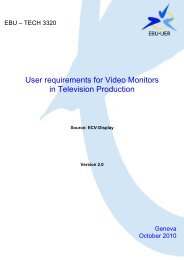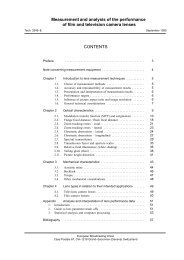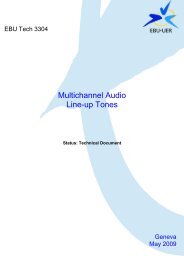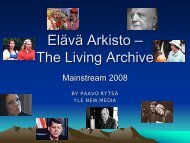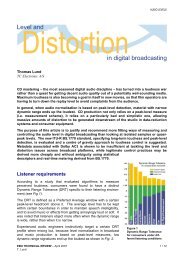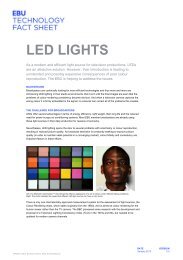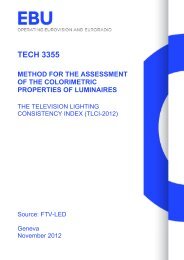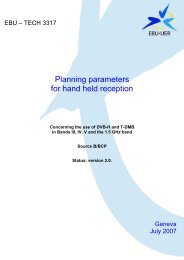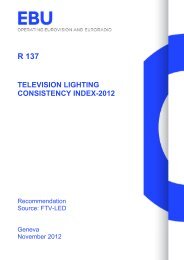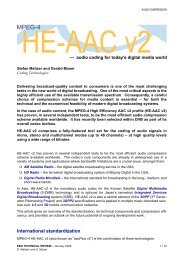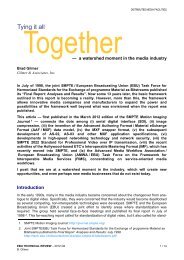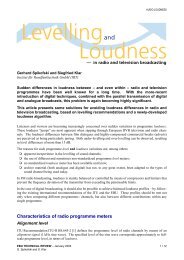Production Technology Seminar 2009 - EBU Technical
Production Technology Seminar 2009 - EBU Technical
Production Technology Seminar 2009 - EBU Technical
You also want an ePaper? Increase the reach of your titles
YUMPU automatically turns print PDFs into web optimized ePapers that Google loves.
3.2.4 Distribution format to the home<br />
The consumer who purchases a television, whether it is '3D ready' or not, should be able to watch the<br />
programmes clearly in 2D or in 3D at the highest resolution possible per-display. Users deserve to be<br />
given the choice. Certain content may be deemed acceptable in anaglyph – thus providing an entry<br />
experience. Perhaps CGI production formats.<br />
Content can be generated by stereoscopic HD cameras, computer generated virtual stereo rigs, or 2D to<br />
3D conversion done offline. Certain technical methods permit a sampling of the left and right frames so<br />
that when the 50% is removed from each view and the content placed in a format known as „side by side'<br />
(SBS) [11]. When viewed on a 46” display, the result can still appear impressive. Issues manifest when<br />
SBS content is played on existing 2D televisions; users will not be able to view the content in 2D. SBS<br />
cuts the resolution per-eye in half, and when transcoding this frame for specific displays such as row<br />
interleaved LCD, there is an additional loss of another 50% resulting in a stereoscopic image that has<br />
only 25% of its original pixels [12] and the rest interpolated. Interpolation techniques that may work<br />
moderately well in 2D have more acute consequences when applied to 3D motion picture images. This is<br />
because interpolating pixels that are geometrically neighbours but dimensionally not neighbours leads to<br />
incorrect depth cues.<br />
In a similar way with 720P vs. 1080i the issue often goes beyond technology. 720P was perhaps more<br />
technically suited to all non cinema content and yet 1080i was easier to sell to the public. Panasonic has<br />
already opened the debate with its “Twin Full HD 3D” message. Taking aside 3DTV for a moment the<br />
most significant issue is the new channel model vs. evolution of 2DHD channel issue. If you have 3D<br />
content as an extension of HD it permits a gradual increase according to the market/budget/skill set and<br />
format suitability. In a similar way that colour broadcasting was mostly consumed in black and white (not<br />
everyone had a colour television when broadcasting started and nor did the quantity of colour content)<br />
3D would fit this evolved format better as a broadcasting proposition than as a new channel model. This<br />
does not stop the eventual migration to full 3DTV channels but the content gap makes this look<br />
challenging to say the least over the medium term (3 to 5 years).<br />
If any format of 3DTV is broadcast that puts both left & right eye views in a single HD frame (1920x1080)<br />
it will need line processing to generate a full 2DHD frame. This line processing is not resident in any<br />
native sets so existing users would not be able to watch the content on their 2D sets. Whilst line<br />
processing may appear a minimal issue it would still, no matter how good it was, be a compromise in<br />
image quality. Attempting to market this to current HD consumers would present issues.<br />
3.2.5 2D Backwards compatibility - key to permit user freedom and gradual introduction<br />
From a FTA broadcasting perspective, for 3DTV to take off, 2D backward compatibility is essential [13].<br />
The simplest way is to use one of the views (if you close one of your eyes, you see in 2D!). Many<br />
consumers will not want to be forced to wear glasses to consume content – even if they had a new 3DTV.<br />
Home consumption has many use cases. You might be watching content, eating dinner or cooking whilst<br />
chatting to friends, etc. This presents challenges to all environments where 3DTV might not be viewed in<br />
3D. For example, a home that has gone for active glasses based 3DTV might only have 4 glasses and in<br />
certain times of the year would have more than 4 people viewing the content. So until auto-stereo 3D<br />
finds a quality experience similar to the first generation of glasses based 3DTV we will never reach the<br />
majority of our potential audience base. This is why a gradual migration is needed from the 2D to 3D<br />
environment. Supporting 3D, at this stage, means the gradual building up of skills and content to provide<br />
the justification bases to purchase an auto-stereo display. It can also re-address any issue over quality<br />
reduction in 2D consumption due to the lenticular lenses until sufficient 3D content would be available.<br />
TDVision Systems Inc. has proposed a standard solution based on '2D+Delta'. This is an advanced<br />
matching correlation of all the pixels and colour information of the left view and of the right view. You<br />
discard what is the same and you end up with the 'Delta' - the difference information [15]. You run a DCT<br />
on this secondary or stereoscopic information, make a modified stereoscopic B-frame (inter-view frame)<br />
and place it in the transport stream. The legacy HD STBs discard the 3D data and simply playback in 2D.<br />
You can also use the delta to reconstruct the full resolution Left, the full resolution Right and prepare the<br />
picture for any type of display whether it is 2D, anaglyph [14], DLP, LCD or dual/single projector. The<br />
latter extending from home cinema all the way to live 3D broadcasting in cinemas/custom screenings.<br />
This abstraction of the broadcast signal from the end consumer device is the only way to permit various<br />
CE vendors to continue to support their preferred technology type with the least bill of material cost in the<br />
© <strong>EBU</strong> <strong>2009</strong> / <strong>Production</strong> <strong>Technology</strong> seminar / January 27 - 29, <strong>2009</strong><br />
Reproduction prohibited without written permission of <strong>EBU</strong> TECHNICAL & <strong>EBU</strong> TRAINING<br />
47



